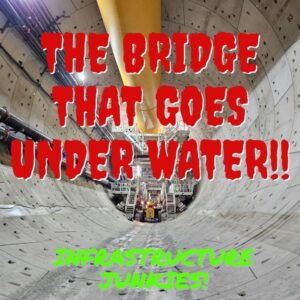
Listen to a podcast episode about this topic here: Infrastructure Junkies: The Bridge That Goes Under Water.
Inching along the bottom of the Elizabeth River is an unlikely creature: Mary the Tunnel Boring Machine. The tunnel boring machine is an integral part of the Hampton Roads Bridge Tunnel Expansion Project. The HRBT adds to Virginia’s latest, greatest, and most magnificent of infrastructure wonders and was recently covered in an episode of the Eminent Domain/ Right of Way/ Infrastructure Development podcast Infrastructure Junkies, linked here: Infrastructure Junkies Podcast – Exploring Eminent Domain, Right of Way, and Infrastructure Development!.
History buffs: what came first? The chicken or the egg? The bridge, or the tunnel? The predecessor to the Hampton Roads Bridge Tunnel was a ferry system which crossed between the Southside and the peninsula. The ferries were operated by the Virginia Department of Highways, took half an hour to cross, and cost $1.25 per vehicle. At the height of traffic, the ferries carried 2,500 vehicles per day. Today’s traffic count exceeds more than 100,000 vehicles per day.
Ryan Banas, PE, CCM, oversees the daily management of the 3.9 billion dollar project, one of the largest infrastructure projects in the country. The HRBT Expansion Project will add two additional tunnels and result in four tunnels and four lanes in each direction. Mr. Banas tied the past to the present, explaining during his interview on the latest Infrastructure Junkies episode that the use of bored tunnel construction is cutting-edge technology. Similarly, the original Hampton Roads Bridge Tunnel, opened in 1957, was the first bridge tunnel constructed between two artificial islands in the world with its companion arriving in the 1970s.
The Hampton Roads Bridge Tunnel Expansion Project seeks to expand the current pair of two-lane tunnels which direct drivers over an initial 5,000 foot bridge, onto the artificial islands, and 100 feet below the surface of the water through the tunnels to the receiving island and bridge.
Exciting historic artifacts have been released through the dredging of the Bay, including five Civil War era cannon balls, World War I & II era military apparel, and an old deck barge from the 1820s still containing the bones of the cattle it was transporting. These historic finds highlight the reality of building in the footsteps of our ancestors and the necessity of connecting Hampton Roads to the rest of Virginia through methods which have the resiliency to withstand the demands of time, environmental factors, and a heavy traffic demand. Resiliency is the name of the game in a region that depends on reliable infrastructure.
In the world of right-of-way professionals, the HRBT Expansion Project builds on the history of the first submersed bridge tunnel between artificial islands, bringing immersed tube tunnel construction to the project.
The HRBT Expansion Project mirrors the driving forces of its original tunnel systems. The original problems still exist: there are too many drivers, and the current infrastructure is not equipped to handle the current traffic flow; but the Hampton Roads region serves several ports with commercial barges, military traffic, and civilian travel over its waterways. VDOT addressed these concerns in 1957 and the 1970s with the original bridge tunnels. Now VDOT addresses these concerns with the Expansion Project. According to Mr. Banas, this project is no less groundbreaking.
The HRBT Expansion Project is another modern infrastructure marvel. This project involves different technology than has ever been used in Hampton Roads. The tunnel being constructed is a bored tunnel, via the use of the tunnel boring machine. This machine is a drill as opposed to the existing method of dredging a channel. The resulting excavation, as opposed to dredging, requires a slurry treatment plant treating the resulting soil.
The tunnel boring machine bores 6 ½ feet in a ‘caterpilling’ motion, with the HRBT Team building rings sequentially behind the machine to frame the tunnel construction. The new tunnel segments, different from the complete ‘tubes’ of the past, are transported the same way as their ancestors: floating down the river. They are submersed by adding temporary concrete blocks to the roof of the segments as they are immersed, with the other technology being building temporary pools inside the segment to decrease the buoyancy.
The right-of-way requirements were a large concern for VDOT, with emphasis on cooperation with local actors and refraining from taking a large amount of additional land. The project has accomplished this goal by requiring two temporary construction easements and only taking one parcel, which will be returned to local regional partner, HR Tech, at the conclusion of the project. As Mr. Banas explained, to minimize property takings, the new bridges takeoff from the same footprints as the current bridges do. This involves a significant amount of staged construction. “So it does make construction a little bit longer, but allows us to not take property. And that’s something that’s really important for VDOT.” Ryan Banas, The Bridge That Goes Under Water.
The HRBT Expansion Project must work with community partners such as the Navy and Hampton University as well as private citizens to acquire the land necessary and keep the regional traffic flowing for the duration of the project.
Another challenge to address is the environment itself, considered in determining appropriate methods for crossing. The soil quality, by virtue of having sedimentary deposits from the bay bottom, negates the foundation required for large bridges. The team has had to build adjacent bridges for local colonial nesting birds to nest on while the islands are being used for construction and launching sites, hiring working dogs to ensure the site remains bird free.
The world of right-of-way depends on the cooperation of independent parties for the highs and lows of ‘public use’. The HRBT relates to this ebb and flow by marking itself as a feat of modern infrastructure, combining eminent domain, cooperation between local actors, and building on the footprint of what’s already there: the bridge that goes underwater.
Catch the full episode and discussion of the Hampton Roads Bridge Tunnel Expansion Project between Ryan Banas, David Arnold, and Kristen Short at Listen – Infrastructure Junkies Podcast.
If you enjoyed this article, please feel free to click the subscribe button below if you are not already a subscriber.
Virginia Augello is an attorney with the firm’s Eminent Domain / Right of Way Practice Group , focusing on the practice group’s eponymous areas of eminent domain and right of way as well as local government work.




Leave A Comment